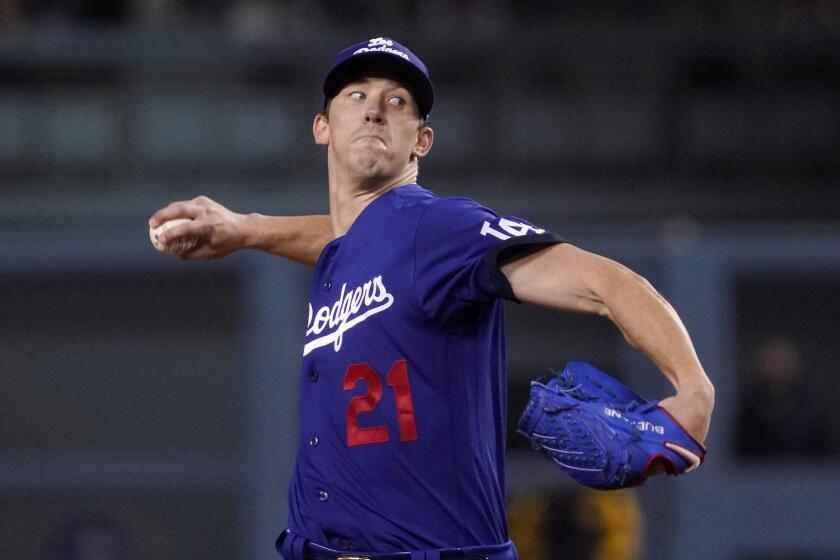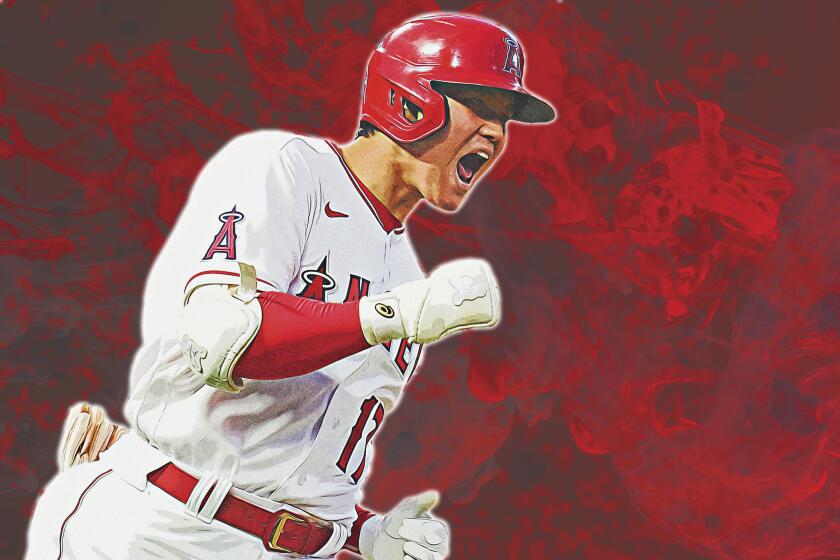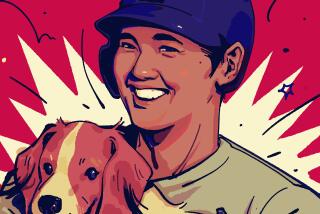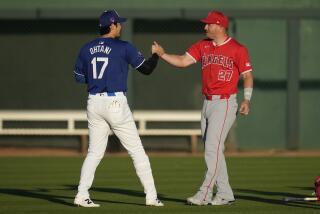What’s the ‘Shohei Ohtani rule?’ A look at MLB rule changes for 2022 and beyond
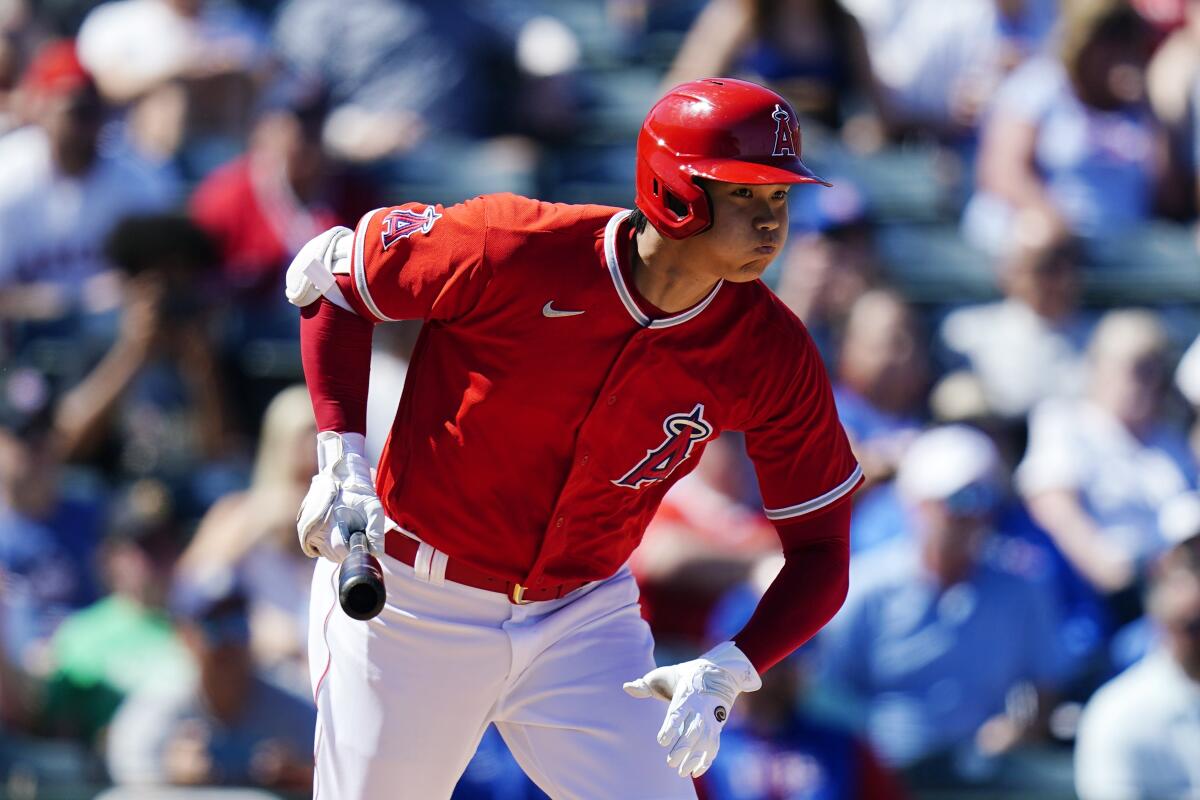
- Share via
It was the fifth inning. The first batter hit a home run to tie the score. Two of the next three batters reached base. Shohei Ohtani was done for the day — or was he?
The Angels wanted to replace Ohtani on the mound, but they did not want to lose his bat in their lineup, not when he was due up fourth in the bottom of the inning.
However, he had started the game as the pitcher, not the designated hitter. In order to keep him in the game for his next at-bat, the Angels had to move him to right field.
The Angels went out in order in the bottom of the inning, so they had to risk playing Ohtani in right field for one more inning. He then batted, dropped a bunt single, was thrown out trying to steal second base, and finally left the game.
In the life of Ohtani, that was one day last May.
No more of that nonsense this season. Under a new rule nicknamed the “Shohei Ohtani rule,” a team can list a player as the pitcher and designated hitter on the days he starts, then remove him in one role but not the other. When the Angels go to the bullpen, Ohtani would be out of the game as the pitcher but would remain in the game as the designated hitter.
This is a fan-friendly rule, because who doesn’t want to see Ohtani bat more often? But it also restores a measure of fairness: Why should Ohtani and the Angels be penalized because of his unique skill? Why should they be forced to limit how long he can hit because of how long he can pitch?
The rule is not limited to Ohtani, of course, even if he figures to be the primary beneficiary. But let’s say the Angels are facing a team using a right-handed opener. The Angels’ pitchers this season include Michael Lorenzen, whose career OPS (on-base plus slugging) against right-handers is .767. The league average last season was .725.
So, in theory, the Angels could start Lorenzen, let him bat against the opener, then keep him in the game as a pitcher while removing him as the DH.
What else is new in 2022? Here’s what:
For this season only
- Rosters expand from 26 to 28 for the first month of the season, giving teams protection for pitchers who might not be able to work deep into games right away because of the shortened spring training.
- The return of the “ghost runner,” as protection against overworking pitching staffs during a season with a condensed schedule, including 30 scheduled doubleheaders. In all extra innings, a team starts its turn at bat with a runner on second base.
For 2022 and beyond
- The designated hitter in both leagues.
- The playoffs expand from 10 to 12 teams. Of the three division champions in each league, the two with the best record get a first-round bye, automatically advancing into the division series. The other four playoff teams meet in a best-of-three series, with the winners advancing to the division series.
- The “Andrew Friedman Rules,” all designed to minimize constant tinkering with a roster in search of even the slightest edge. Pitcher Mitch White, for instance, was sent down to the minor leagues by the Dodgers 11 times last season, sometimes a day or two after he was called up. If starting pitchers can work deeper into games, all the better.
Named the opening day starter for the first time in his career, Dodgers pitcher Walker Buehler always makes quite an impression on those around him.
The changes: If a team wishes to demote a player already optioned five times that season, every other team must first get the chance to claim him on waivers. (For this season, options prior to May 2 do not count against the new limit.) And, starting May 2, teams are limited to 13 pitchers on their active roster, with the minimum stay for a pitcher on the injured list rising from 10 days to 15.
- The player payroll a team can field without having to pay a luxury tax increases from $210 million last year to $230 million this year. That figure rises to $233 million in 2023, $237 million in 2024, $241 million in 2025 and $244 million in 2026.
- Players not yet eligible for salary arbitration, most of whom play for a salary at or near the minimum of $700,000, are eligible for performance-based bonuses from a pool of $50 million per season.
Shohei Ohtani and many in the Angels organization believe the two-way sensation can improve on his historic 2021 season.
Starting in 2023
- A draft lottery, so that the team with the worst record one year does not necessarily pick first the following year. The 18 non-playoff teams will qualify for the lottery, although large-market teams cannot qualify in two consecutive years and small-market teams cannot qualify in three consecutive years. The top six picks among those 18 teams will be determined by lottery, the rest in reverse order of winning percentage.
- Free agents would no longer be subject to qualifying offers, meaning a team would no longer forfeit draft picks by signing a free agent. (However, in order for this change to take effect, the players’ union must agree by July 25 to an international draft. As a result, a top prospect from the Dominican Republic or Venezuela would no longer sign with a team as a free agent but would be limited to signing with whatever team drafts him, as is currently the case for top prospects in the United States, Canada and Puerto Rico. If an international draft is adopted, MLB hopes to launch it in 2024.)
More to Read
Go beyond the scoreboard
Get the latest on L.A.'s teams in the daily Sports Report newsletter.
You may occasionally receive promotional content from the Los Angeles Times.


